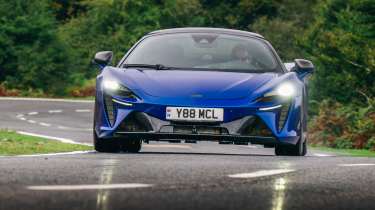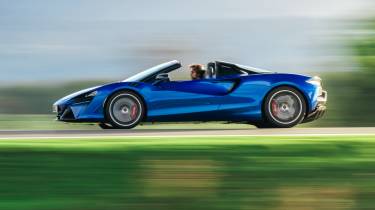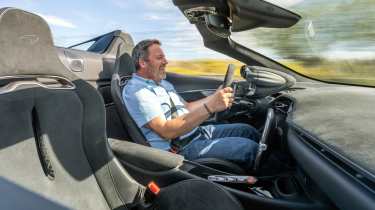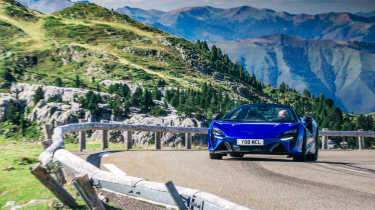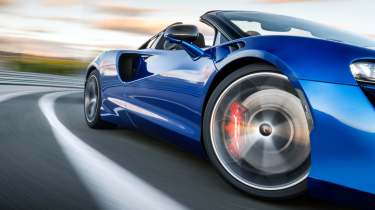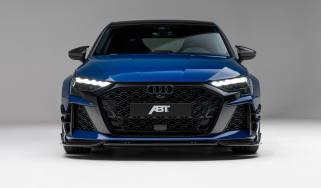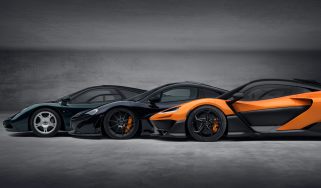McLaren Artura Spider 2025 review – Britain's Ferrari 296 rival just got a whole lot better
More power, comprehensive chassis updates and a new Spider model makes McLaren’s Artura impossible to ignore for those in the junior supercar market
To say the McLaren Artura had a troubled birth would be a mild understatement. Delayed media drives that, when they did take place, ended in failed HVAC systems, split oil lines and fires. This naturally resulted in delayed customer deliveries, which of course meant a hit in the P&L and cash into the business, hurting McLaren further still as it had far more cash going out than coming in.
Despite this, 2000 Artura coupes had been delivered since the end of 2022, and now they are obsolete. Sorry existing Artura owners, but McLaren’s ‘facelifted’ Artura, which now includes a Spider, is such a comprehensive makeover that if you stepped from the original to the new you’d be forgiven for thinking they were different models. These changes also helped it finish joint second in evo Car of the Year 2024...
> Ferrari 296 GTB review – fewer cylinders, greater thrills
Following its incredible eCoty performance, John Barker said: 'More than just an open-top derivative of the original Artura coupe, which finished equal third on eCoty 2022, this Spider version has been refined in many ways and its V6 hybrid electric powertrain now delivers 691bhp. It’s a handsome, exceptionally capable car with terrific feel and great refinement.
More reviews
I hadn’t driven the original but at the end of the week had the Artura at the top of my scorecard, just a point ahead of the MX‑5. I loved it. It’s a proper supercar in looks, cockpit ambience and performance and it’s also the best McLaren I’ve driven in terms of polish and bandwidth. I found it great to drive on any sort of road, whether you’re ambling or going for it, with a brilliant ride, fluid dynamics and superb steering.'
Henry Catchpole was a big fan too, placing it second to only the MX‑5: ‘Like the Mazda, the McLaren was enjoyable every time – even before the V6 woke up. The reclined seating position, the clear view out, the tactile steering, the supple ride – they all feel special and make you feel comfortably at one with the car straight away. That deep sense of connection through hands and backside meant that – again, like the Mazda – it was enjoyable and possessed flow, whatever the speed and whatever the road.’
His one gripe was that the engine needed to be revved out to feel like it was delivering the expected performance, and the V6 was a sticking point for others, Meaden included. ‘McLaren really are mastering the art of mid-engined cars,’ said Richard Meaden. ‘Sadly, they don’t know how to make expressive, emotional engines. Yes, the V6 has some fire right at the top end, but with all that turbocharged and hybrid-assisted torque you rarely need to work it that hard. I think I’m just getting fatigued by cars that deliver so much with so little effort. I respect the overall achievement but don’t derive any lasting emotional connection.’
James Taylor echoed Meaden’s thoughts, saying that the engine was short on character much of the time but that the only reason he didn’t vote it higher was because he craved a little bit more drama and excitement more of the time. Stuart Gallagher enjoyed how the Artura could feel like a GT one minute and an unhinged, scary and exhilarating supercar the next: ‘The powertrain is perhaps its biggest weakness, not in numbers but with its rather subdued soundtrack, but that’s it, the rest is pure thrills.’
With its roof open (requiring eight e-motors to operate the 15kg section) the new glass buttresses sparkle when the sun catches them and along with the revised engine cover featuring new cooling intakes for the hybrid V6 motor now that there is no room for the coupe’s ‘cooling stacks’, the Spider it stills look very much like every other McLaren. Hopefully new head of design Tobias Sühlmann has been given plenty of blank sheets of paper to sketch what comes next. Beating the cooling upgrades for subtlety are the pair of gurneys on the leading edge of the windscreen header rail, that require a McLaren tech to point out to you.
There’s no intrusion to the cockpit to accommodate the roof mechanism, nor are there any structural rigidity losses over the coupe and the ergonomics remain hard to fault in terms of how your torso aligns with the instrument stack (fixed to the steering column and therefore moves as one) and your line of sight. The wheel arch intrusion into the footwell does require a twist of the hips to get you feet where you want them to be on the pedals, however, so try before you buy.
With the roof open there’s noticeable turbulence around the top of the pillar behind your outer shoulder, and if you drop the glass screen that sits between the buttresses when the roof is open you’re simply adding to the air ingress. Best to leave it in place until you raise the roof again, then you can drop it to hear the beefed up V6’s soundtrack, although with the roof closed and even with the optional sports exhaust it’s piped into the cabin through a Bowers & Wilkins speaker positioned between the seats.
Despite the Artura losing its head being the headline news, the big changes, the significant ones that raise its bidding, are mostly unseen. Chief amongst these are those changes made to the 3-litre turbocharged V6 engine, which receives a 20bhp boost to give the Artura 597bhp delivered between a revised power curve of 4000 and 8500rpm. There’s been no change to the hybrid system (94bhp and 166lb ft of torque) that includes an axial flux motor in the propshaft within the bellhousing and the 8kWh battery that’s still mounted towards the rear of the monocoque floor. The e-motor still acts as the reverse gear leaving the eight-speed dual-clutch introduced on the coupe to focus on forward propulsion. Of which there is now rather a lot, the powertrain producing a 690bhp peak.
That additional 20bhp might not read like much, it is after all less than a four per cent increase, but the remapping of how it’s delivered that focuses on allowing the V6 to rev out with more vigour is very noticeable. Where previously it would tail off in its delivery as you approached its peak with a feeling you were holding out for the higher rpm limit for the sake of it, the speed the motor now maintains as you stretch it, keeping you hooked and engaged as you hunt down every last rpm. At its quickest it will reach 62mph in 3sec, 124mph in 8.4sec and 186mph in 21.sec. Top speed is an academic but impressive (for internet bragging rights) 205mph.
25 per cent faster gearshifts add to the increased adrenaline that flows through the car, and while the hybrid system remains unchanged, the recalibration of the car’s electronics result in it having a stronger impact on how it gets down the road, specifically out of slower corners and when you’re leaning on its sizeable mid-range. If you don’t want to get busy with the top end there’s more than enough meat in the mid-range to gorge yourself on that makes many supercars feel a little leggy. Few do raw performance as well as McLaren.
Few do dynamics as well as them either, and the opportunity to enhance the Artura’s chassis wasn’t passed up. New engine mounts allow the V6 and Monocell carbon tub to react to inputs as one, rather than generating movement at different rates as before. There’s also an updated domain controller for the Proactive Damping Control, the dampers themselves have new valves and the adaptive software has been recalibrated too. Of larger significance is the new damper shim stacks and, where previously McLaren used an off the shelf nut to secure the damper to the suspension arms, there's now a bespoke nut machined to its own specification.
The result is transformative, specifically to how it steers rather than how it rides and manages its body control, which remains at the same high McLaren standard. The compliant nature in how it breathes with the surfaces remains at odds with what your eyes are telling you should be happening beneath you. Yet it’s the new found calmness of the Artura’s steering that strikes you most. McLaren has stuck with its electro-hydraulic set-up, still remaining unconvinced by full EPAs systems, and it’s still sharp and crisp in its responses, clear and concise in its feedback, confidence inspiring and rich in detail and feel when you start to eat away at a corner’s radius.
There’s another element now, too, which has eradicated all but the most extreme kickback through the wheel that previously told you that the front axle was being given a work over but not to worry because everything was still heading in the expected direction. Now you still have great feel and feedback, accuracy and linearity but gone are the higher forces working your hands on the wheel making for a much more precise and rewarding car to build a flow and rhythm with.
Weighing in at 62kg heavier than the coupe, there’s no dynamic pay-off for opening the Artura’s roof. It still entertains and rewards and showcases its motorsport DNA at every opportunity, delivering a supercar experience regardless of your speed. Improved brake cooling has improved both the pedal consistency and the stopping performance, any lengthening of the pedal during repeated high temperatures and high speed stopping is consistent and allows you to manage and compensate for the pressure you apply.
McLaren considers this update to be as significant as the one that took the 720S to the 750S and on this evidence it is hard to object to such a statement. The only fly in the ointment is that those 2000 early customers will only be able to benefit - free of charge - from the engine remap. The hardware changes are too complex to be carried out on a car that’s already been built. Which is a huge loss for them, but those who have been waiting and are due an updated Artura are in for a very special treat.
Price and rivals
Let’s start with the Ferrari 296 GTB, which carries a £279,618 price tag that works out to be a not insignificant £58,118 more than McLaren charges for the Artura Spider (£221,500 in case your calculator is misplaced). Maserati’s MC20 Cielo costs from £247,025 and that’s pretty much your lot when it comes to the mid-engined open top cars now both the Lamborghini Huracán Spyder and Audi R8 Spyder are no longer in production.

